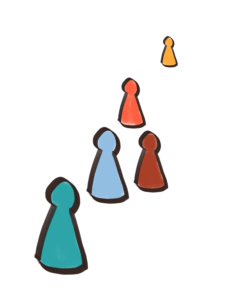
When dealing with racism, it is worth looking outside the box of discrimination and disadvantage, by looking at your own position and privilege.
A popular reflections exercise (in different variations and forms) is the game “step forward”, also known as, “like in real life”. The basis of the exercise is to ask the participants questions. If the participants can answer a question for themselves with “yes”, then they move a step forward. If they cannot, then they remain where they are. As the questions delve into very personal issues, the exercise can also be “defused”, by letting participants switch to different identities
Brief Description
Target: To get to know the other participants and to understand and reflect on stereotypical and prejudiced thinking Duration: 60 Minutes Additional Material and Instructions: Role cards and detailed descriptions of the “like in real life” exercise can here (PDF, 51 KB)
Questions for the game could be, for example: Can you…
- … take out a motor vehicle liability insurance?
- …spend a holiday in your home country?
- …expect fair treatment from the police when reporting a theft?
- …get a bank loan to renovate a rental apartment?
- … plan a family?
- …receive dental treatment if you would like to?
- …feel safe on the street after dark?
- …expect sympathy and support from your family?
- … plan 5 years ahead?
- …kiss your partner on the street?
- …vote in the next election?
- …choose your choice of residence freely?
- … exercise your religion openly and without any problems?
- …assume that you or your children are not discriminated against at school?
Evaluation
The evaluation is broken up into two phases.
For the first phase, all participants should stay in the positions that they were in after the last question. Let everyone look around at where they are in the room. Ask them how it felt to be in this role. When did they realise that they were making progress, and when were they not?
The second phase of the evaluation can either take place in a circle of chairs or in small groups. Discuss the questions as to why some people progress and some do not? (i.e. the importance of passports, skin colour, gender, sexual orientation, age, religion and social status)
Alternatively, the set-up of the exercise can vary, for example, by forming a circle at the beginning. The participants should hold each other’s hands or shoulders and move forwards or backwards. The steps are more important than the preservation of the circle. This means, that when the circle is stretched too far, the participants have to let go and continue.
Detailed instructions for the “step forward” exercise can be found here.
Source: Baustein für nicht-rassistische Bildungsarbeit; Anti-Bias-Werkstatt und GLADT e.V
Translation: Fred Taucher
Read original article in German.

Dieses Werk ist lizenziert unter einer Creative Commons Namensnennung-NichtKommerziell-Weitergabe unter gleichen Bedingungen unter gleichen Bedingungen 3.0 Österreich Lizenz.
Volltext der Lizenz

